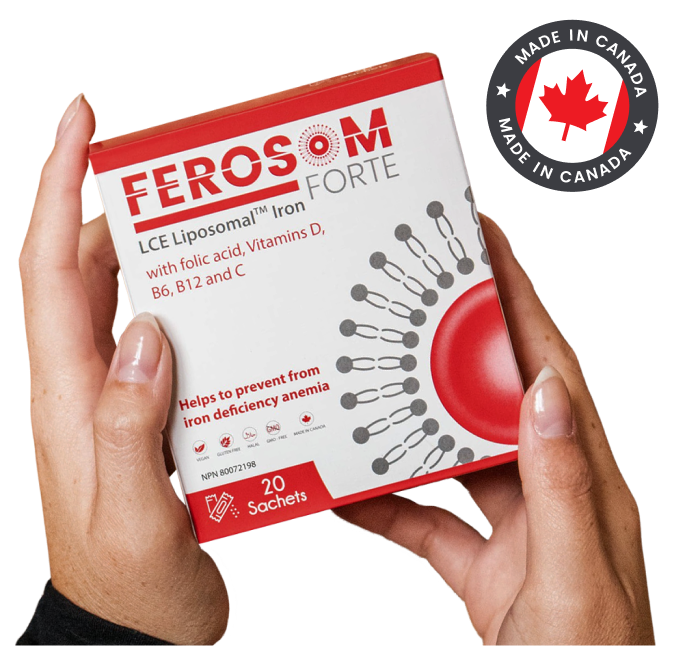

Over 1% of the US population has celiac disease. We’re talking 3 million+ people in America alone. But somehow, this chronic autoimmune disorder remains difficult to diagnose and easily mistaken for other conditions.
There are a few reasons for this. The most notable is that celiac disease can also lead to other complications, like iron deficiency anemia. And when condition crossover starts happening, figuring out the right diagnosis or treatment plan can get a bit tricky.
So how are celiac and anemia connected? And what can you do to boost iron levels if celiac disease is causing them to fall? Let’s dive in.
What is celiac disease?
Celiac disease is a genetic autoimmune disorder triggered by gluten—a protein found in wheat, barley, and rye. When people with celiac consume gluten, their immune system mistakenly attacks the lining of the small intestine, causing inflammation and damage.
What does celiac disease feel like? Here are a few common symptoms:
- Chronic diarrhea or constipation
- Weight loss
- Gas or bloating
- Stomach pain
- Pale, bad-smelling stool
Symptoms can sometimes be hard to spot or correctly diagnose. In fact, 83% of people who have celiac are undiagnosed or misdiagnosed with another condition. So if you’re experiencing any of the above symptoms, talk to your doctor about getting tested for celiac.
How is celiac disease connected to anemia?
Iron deficiency anemia is one of the most common complications associated with celiac disease. That’s because when the intestinal lining gets damaged, it’s not able to absorb vital nutrients—like iron.
Iron is the nutrient that creates hemoglobin, a protein that helps red blood cells carry oxygen throughout the body. Low iron can therefore cause a lot of problems, some minor and some more serious.
What are the symptoms of iron deficiency anemia?
There are so many ways that iron deficiency anemia can show up in your body. The most common symptoms include:
- Extreme fatigue or weakness
- Pale skin
- Cold hands or feet
- Shortness of breath
- Rapid heart rate
- Headaches
- Dizziness
Here’s where things can get confusing. People experiencing these symptoms will often be tested for and diagnosed with low iron. From there, they can be treated for the deficiency and work on boosting their iron levels. Awesome, right?
Just one problem: The root cause of the deficiency (celiac disease) is not being identified. So even if iron levels are addressed, the person might continue eating gluten and fall back into the same pattern of symptoms. No wonder it can take anywhere from 6 to 10 years on average for people with celiac disease to be correctly diagnosed.
What is the best way to treat low iron caused by celiac disease?
Regardless of the cause, low iron should be treated as soon as possible.
One way to do that is through diet. Eating more iron-rich foods—like red meat, poultry, and eggs—can help you increase iron levels over time. But if the small intestine is still impacted by celiac disease, it can be difficult for all that extra iron to be absorbed into the body.
That’s why iron supplements are typically the most effective way to treat iron deficiency caused by celiac disease.
What should people with celiac disease look for in an iron supplement?
Iron pills can make the symptoms of celiac disease even worse. That’s because most iron supplements cause harsh gastrointestinal side effects, like constipation or diarrhea.
When choosing an iron supplement for celiac disease, it’s important to look for 2 main criteria:
- Gluten-free formula.
This one’s a given. If you have celiac disease, make sure your iron supplement is certified 100% gluten-free. This ensures the supplement won’t make symptoms worse or interfere with your intestine’s healing process.
- Liposomal form.
This one’s a little less obvious—but a total game-changer. Liposomal technology encapsulates the iron within a protective layer. Think of it like a barrier, shielding the iron from acid breakdown in the stomach and bypassing the damaged intestinal lining caused by celiac disease. Liposomal iron also has high bioavailability, which means it’s able to get where it needs to go quickly and efficiently.
To put it simply: Liposomal iron supplements have fewer side effects and extremely high absorption rates—similar to certain doses of IV iron.
What’s the best iron supplement for anemia caused by celiac disease?
Ferosom Forte is a 100% gluten-free Liposomal iron supplement with the highest absorption rate on the market—and the fewest side effects. Case in point: 88% of Ferosom Forte customers did not experience any side effects at all.
Available in both capsule and sachet form, Ferosom Forte is the best iron supplement for celiac disease. It’s even formulated with vitamin C for an extra boost of absorption.
Celiac disease doesn’t have to run the show.
Celiac disease can feel like an all-consuming condition. The symptoms are painful and sometimes debilitating, and maintaining a gluten-free diet is the only way to manage celiac disease long-term.
But knowledge is power. By staying educated on your condition, connecting with others who live with celiac disease, and working closely with your doctor, you can take steps to combat symptoms—like iron deficiency—and significantly improve your quality of life.
RESOURCES USED:
https://www.ncbi.nlm.nih.gov/pmc/articles/PMC5872748/
https://www.ncbi.nlm.nih.gov/pmc/articles/PMC4541375/
https://www.buoyhealth.com/blog/supplements/best-iron-supplement-for-celiac-disease#
https://www.hopkinsmedicine.org/health/conditions-and-diseases/celiac-disease
https://www.beyondceliac.org/celiac-disease/facts-and-figures/







